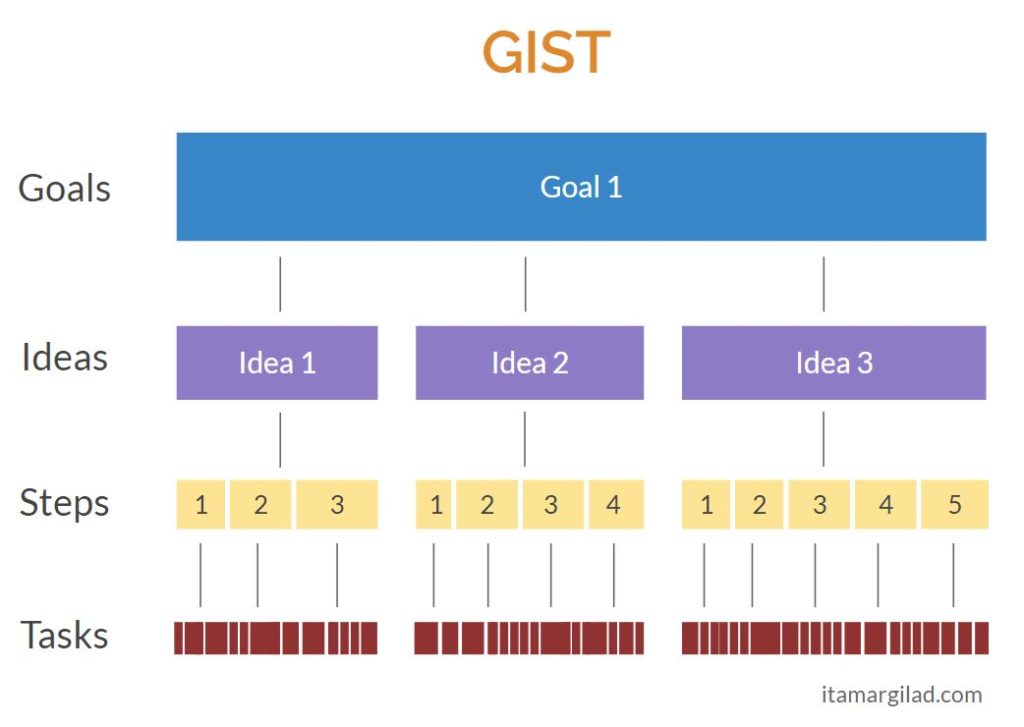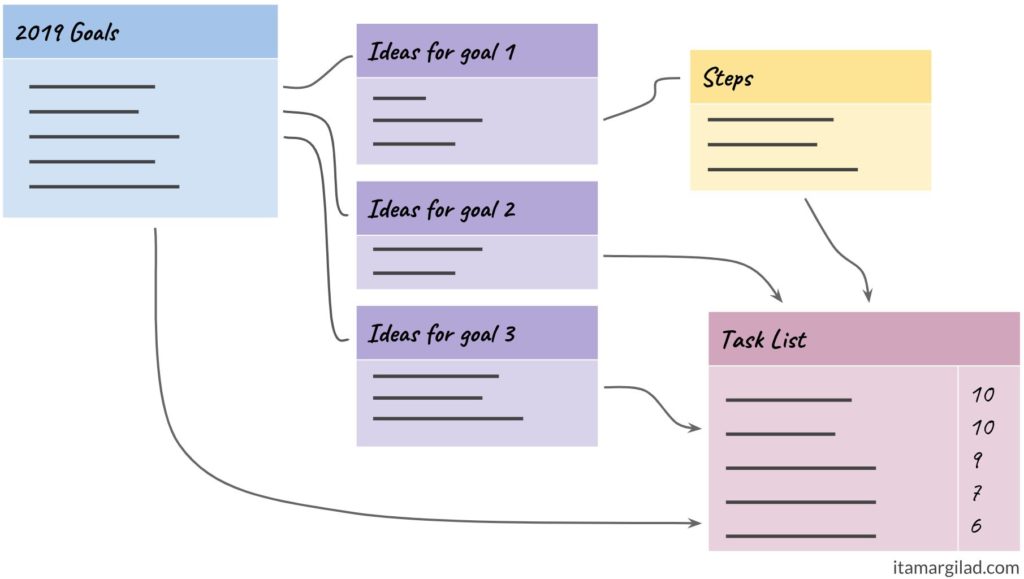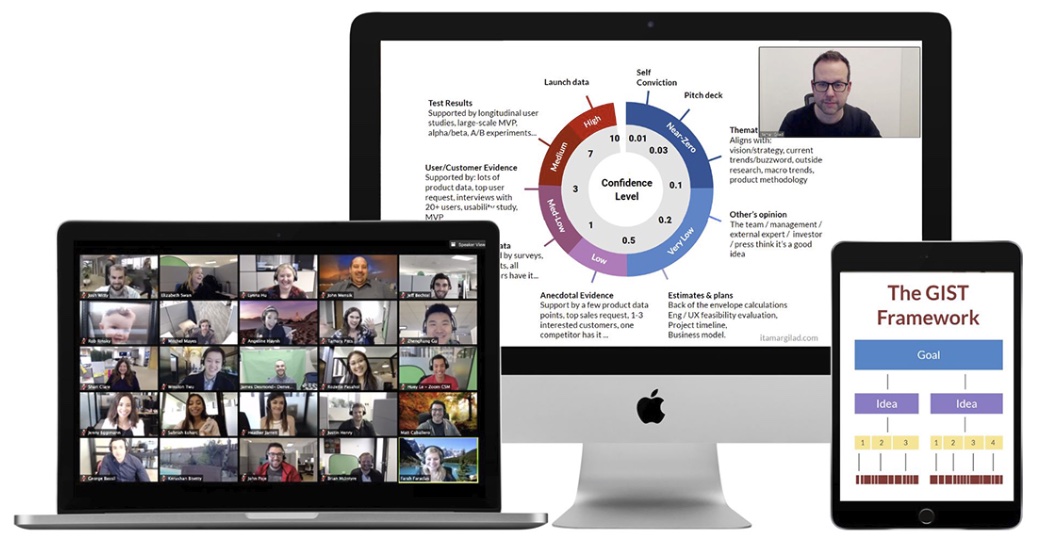Staying productive is as challenging to me as it is for most people. Procrastination, constant feeling of not doing enough, working long hours — I have all the symptoms. However, as I started working with companies and observed their notion of productivity, often keeping everyone busy chasing projects that lead nowhere, I started seeing the flaws in my own perceptions:
- Like many companies my plans were mostly based on intuition and gut feeling, yet they were not agile enough to cope with uncertainty and not helping me accomplish my goals.
- Like many teams I measured my productivity by output (number of tasks completed) rather than by outcomes (goals accomplished, impact achieved).
- Like some Agile dev systems, my productivity system was steering me to focus on the here-and-now, and was ill-equipped to help me achieve long-term goals.
Today I help companies address such challenges by using the GIST planning framework. The topic of this blog post is how I use a lighter version of GIST for my own personal work and life projects. At the end of the article you’ll find also an Airtable template that I use to manage the system. This is a diversion from my usual product management topics, but maybe a fitting one for the start of a new year.
What is GIST
GIST is a framework for product planning I created based on the principles of Lean Startup, Growth Marketing, Behavioral Economics and more. It breaks planning into four parts — Goals, Ideas, Steps and Tasks.

Simply put, goals define what we wish to achieve, ideas are hypothetical ways to achieve the goals, steps are mini-projects that implement an idea in parts while validating it, and tasks are the day-to-day activities that implement a step. Early versions of GIST worked very well for me as product manager at Google, and I since helped numerous companies implement it with consistent positive results.
The problem with task lists
All my past personal productivity systems were centered around task lists (aka To-do lists). I must have gone through dozens of variations using mobile and desktop apps, written notes, stickies, calendars and more. They all failed. With GIST in mind I finally understood why.
Let’s look at a sample task list of mine (like all the examples in this post it is fictitious, but inspired by my own life):
Tasks
- Learn Spanish
- Get back to Bob about the proposal
- Set up call with Alice about speaking op
- Write a blog post about GIST for personal life
- Jog at least twice a week
- Travel to Japan
- Set dentist appointment
- Set up a forum for the GIST community
- Redesign website
- Build an audience
- + dozens more
Do you see the problem?
Essentially I crammed goals, Ideas and tasks into one flat list.
Tasks
- Learn Spanish ← Goal
- Get back to Bob about the proposal ← Task
- Set up call with Alice about speaking op ← Task
- Write a blog post about GIST for personal life ← Idea
- Jog at least twice a week ← Idea
- Travel to Japan ← Idea
- Set dentist appointment ← Task
- Set up a forum for the GIST community ← Idea
- Redesign website ← Idea
- Build an audience ← Goal
Mixing goals, ideas and tasks in one list is bad on multiple levels; It bloats the list with things that are not tasks, and (worse) prevents goals and ideas from being accomplished — they linger in the task list for months, only to get pushed down by tasks that are less important, but more urgent.
The first order of things is therefore to separate goals and ideas into their own lists.
Moving to Multi-Level Planning
Separating goals, ideas and tasks introduces surprising clarity even for the most mundane of goals.
This structure enables me to think top-down: first set goals, then think of ideas, then break top ideas into tasks. Now I can manage each level separately and compare apples-to-apples. My task list becomes notably shorter too. All of this improves the odds of accomplishing the goals.
In my work projects I sometimes use all four GIST levels, as I don’t want to over-commit to one costly idea upfront.
I’ll explain this example below.
Let’s look at the different parts of the system up close.
1. Start with Goals
I always had mixed opinion about setting personal goals. Personal OKRs felt like a lot of overhead, and often amounted to nothing more than new year’s resolutions. With GIST I am more bullish about personal goals as I have a clear way to act on them.
All of us have certain persistent life goals, for example:
- Take care of family
- Stay healthy and fit
- Personal growth
- Become financially stable
- Succeed at work
- Have fun
- Help those in need
- Etc.
I find it useful to go over this list once a year and derive from it yearly goals that answer the question “where do I want to be by end of this year?”.
Let’s take “Learn Spanish” from my original task list. For context I live now in Spain, so proficiency in Spanish is of medium-high importance. This is clearly a goal, but it is articulated badly — Learning Spanish is an activity (and a rather vague one at that). Becoming proficient in Spanish is the real goal and that’s what I should put in the goal list. But then an immediate question comes up — what do I mean by “proficient”? Setting the goal vaguely may mean I don’t have a concrete target to aim for. To fix this I can phrase the goal as an Objective and key results (OKR):
Objective: Become proficient in Spanish
- Key result 1: Be able to order food at a restaurant
- Key result 2: Be able to carry out a casual short conversation
- Key result 3: Be able to watch a movie in Spanish with no subtitles
- (etc)
Let’s say that for 2019 I’d like to be able to carry a casual, short conversation (KR2). It’s not a very measurable key result, but I can sense how far I am from achieving it every time I hold such a conversation, which is quite frequent and good enough for me.
Note: not every personal goal needs key results — some are fairly self evident.
Here’s what a yearly goal list might look like (again, not my real 2019 list, just an example).
I’ll revisit this list every 2–3 months to make sure I haven’t lost sight of any of my goals, add new goals, and remove or demote old ones as needed.
2. Collect Ideas
If there’s only one way to achieve the goal and it’s fairly short and actionable I’ll skip idea collection and create a task. In many cases, though,taking time to consider the options can save time and effort down the road. In such cases I’ll create a list of ideas (AKA Idea Bank) per goal to help me record ideas and prioritize them. I also have a list for Miscellaneous ideas that are not currently connected to any goal. Whenever I come across another potentially good idea I’ll add it to the relevant list. Again, a task list is definitely not the right place to keep ideas — most ideas will never be implemented and they’ll just bloat the list.
These are some of the ideas I may consider for the Spanish proficiency goal:
- Free online courses
- Paid online courses
- Spanish night school
- Personal tutor
- Language exchange program
These are all valid ways to learn a new language, but how do I choose? As I research the ideas I’ll Implicitly consider the three elements of the ICE score:
- Impact — how fast and how well will this method get me to be able to converse in Spanish
- Ease — how easy is it going to be in terms of time, effort, convenience and monetary cost
- Confidence — how sure am I about that this idea is going to work? (for example do I know anyone that managed to use it?)
I don’t calculate ICE scores explicitly, but it’s a useful way to evaluate the options.
If you prefer to receive posts like these by email sign up to my newsletter.
3. Define Steps to implement and validate the idea (Optional)
Often personal ideas can immediately be turned into tasks. For example if I chose to travel to Japan, there are no intermediate steps to accomplish this idea, just a list of tasks.
However when an idea is large and brings a high level of uncertainty it’s useful to implement it in Steps. For example as I started consulting it was clear that I will need a personal website. However early on I didn’t know enough about my market, the needs and where can I deliver most value. Designing and implementing a rich website at this point would have been quite wasteful. I needed to first learn, so I took step-wise approach.
Step 1: A PDF document
The first step was to create a simple PDF file containing a short bio + a long list of potential consulting services. I publicly shared it from a Google Drive folder, and had my domain itamargilad.com redirect to the published doc. Whenever I got in touch with a new collaborator or potential clients I would forward them the file over email. Over time I iterated and updated the doc based on what I learned. This was my website MVP.
Step 2: Google Sites
The next step was to create a simple website. At this point I felt I understood my basic value proposition and I had more online exposure (although traffic was still quite low). I still had to learn a lot and was not quite sure about the content I wish to put out. So I went with the simplest and most hassle-free way I could find — Google Sites. Google Sites is mostly intended for internal company use and (intentionally) offers limited options. Still as my goal was to have a somewhat more advanced MVP that will let me learn faster, i didn’t mind.
Step 3: WordPress website
Once I established more of track record and needed to grow my online presence I was ready to invest in a richer website based on WordPress. This isn’t the end thing (definitely it’s in need of some design and probably I need a new headshot…), but it’s good enough for my current needs (you can see it at itamargilad.com).
4. Create tasks
Now that you’ve mapped your goals, ideas and steps, creating tasks should be fairly straightforward. I use just one task list and one calendar for everything. Tasks should be concrete and ideally contain a verb — purchase X, meet Y, find Z. I give each task a priority bucket number between 1–10 with 10 being highest priority and I always have my task list sorted by priority. I try not to have too many 10s because then I may have to go to 11.
Putting it all together
The database
I keep the entire system in Airtable — this is the template I use — feel free to copy, modify and share, but please attribute back to this post.
The cycle
Our work and personal lives have a fair amount of unpredictability, so it’s important to stay agile and revisit every part of the system regularly.
- I create goals yearly, but try to visit and update them at least once every other month. I don’t use OKR scoring, but I do try to evaluate how much progress I’m making on each goal and whether I’m on track to achieve it.
- I create idea banks whenever I have new goal or a new potential big project. I also have a Misc idea bank. As I come across a new idea I like I add it to the relevant idea bank. I visit the idea banks when feel that the current ideas have run their course or when I need inspiration.
- I try to think of Steps before committing to any big new project, but I rarely write them down explicitly.
- I look at my task list multiple times per day on mobile and on desktop and constantly update it — add new tasks, reprioritize, remove completed or obsolete tasks. Some tasks will go directly to my calendar rather than to my task list.
Takeaways
Our lives (Personal and work) aren’t just a series tasks to complete, just like a product development isn’t just a series of user stories to build. By switching to a GIST-based personal productivity system I was able to gain set of important benefits:
- Helps me articulate and remember my goals
- Reminds me to think of more than one idea
- Encourages me to give more than one idea a shot.
- Lets me to test big ideas before committing
- My tasklist is shorter and has only tasks
- I feel like I’m always working on the most important things at any given point.
- I haven’t switched to a new system tasklist for over a year now
I’m no productivity expert and what works for me may not work for you. Still I encourage you to try the GIST approach in your own personal or work life and later let me know how it went.

